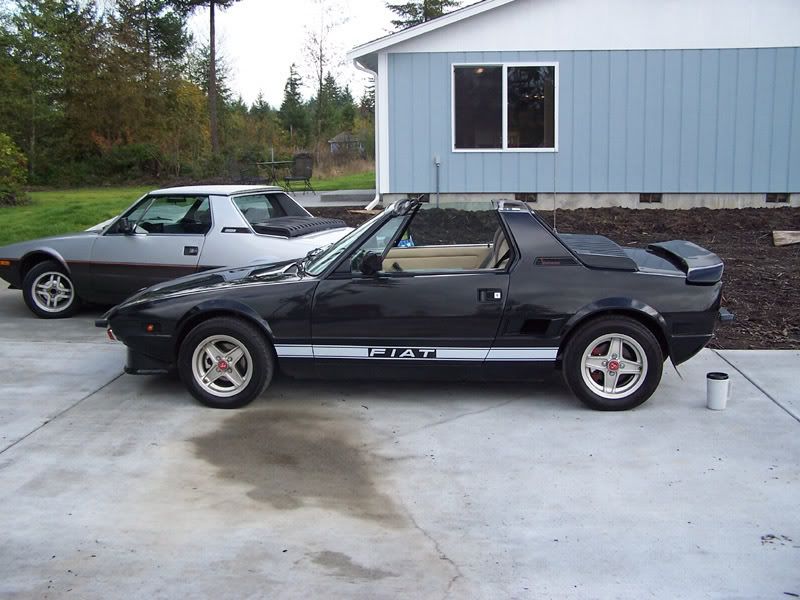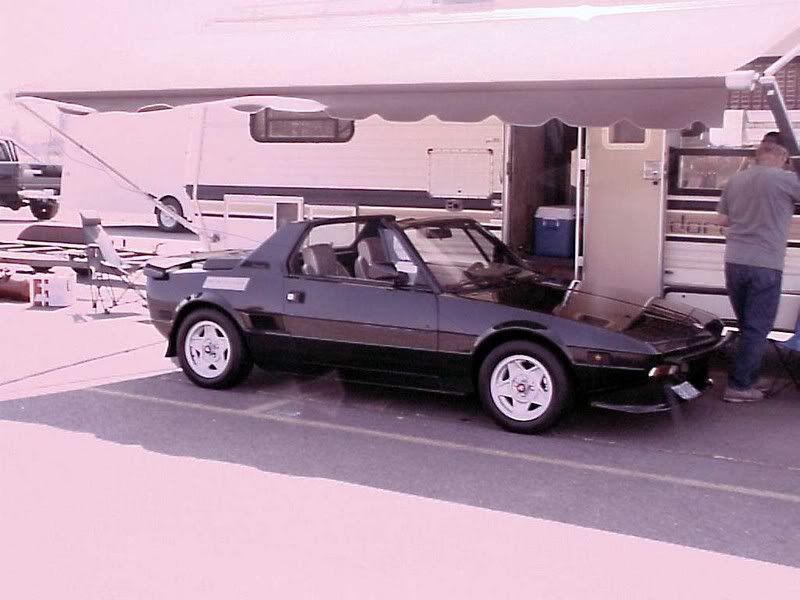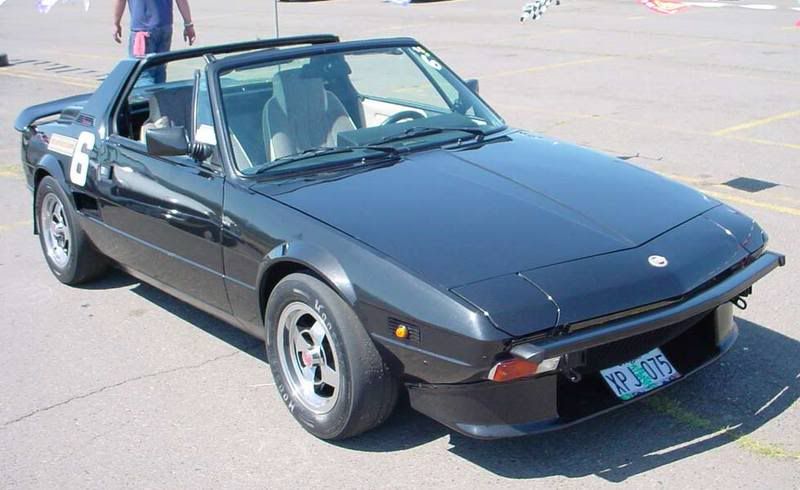Man...that GRM article was about 10 years ago!
Three 128s & my BlackX were pictured in article.
Not much content specific to the pictured cars.
Sadly, 2 of the 128s have been scrapped.
The other 128 is now my daily driver.
Below is exerpt regarding hotrodding the 128
from that article, written by talented tuner,
world class driver, and author Chris Hartman.
I have the rest of the article regarding history and specs if anyone is interested.
**********************************************************************
Hot Rodding the 128 by Chris Hartman
The Fiat 128 is a perfect choice for hot rodding. It seems as if Fiat designed the car to support elevated power outputs and the increased grip afforded by race tires. Better yet, there is a long list of aftermarket parts and suppliers - as well as upgrades from later model Fiats - which have been proven in the heat of competition.
Starting at where the rubber meets the road, 128 owners can drastically improve the handling of their car by ditching the skinny wheels and tires in favor of something wider. At minimum, a simple upgrade to wider 5-inch steel wheels - from the 124 and 131 series cars - can make fitting wider tires a reality. Another popular upgrade is to find any number of stock aluminum wheels, offered in 5 and 5.5-inch widths that were available on X1/9 and later 2000 Spiders. Staying in the corporate family, wheels from the Lancia Beta series - 14x5.5 inches - can just fit inside the fenders of a 128, and lend a unique appearance.
Several aftermarket companies have offered wheels for the Fiat-specific 4x98mm bolt pattern, including Chromadora, Daytona, and Campagnolo. Many of these designs are cherished among the Fiat community. A good market also exists for autocross and road race fans, as companies like Ultralite and Revolution offer Fiat-specific wheels, with custom widths and backspacing available. A cheap route for the part time local racer is to have custom steel wheels made, using the stock Fiat centers.
In addition to wheel upgrades, upgrading to wider, more performance oriented tires offers a significant improvement in overall grip and driving fun. For the daily-driven 128, a good choice would be a 175/70-13, a size available in countless designs. Another popular tire size, the 185/60-13 - is an excellent choice for owners with wider wheels to match. This used to be a much more common size, but now days is limited to selections like the venerable Yokohama AVS-I, which can also perform admirably at an autocross or during road course play days.
All out DOT approved racing tires are still available in 13-inch sizes, with the Yokohama A-032R, Kumho Victoracer V700, new Kumho Ecsta V700, and Hoosier radials available in widths from 175mm to 235mm, the latter requiring custom wheels and fender modifications. For enthusiasts who like to venture off road, any number of 13-inch rally tires are offered by Michelin, Kumho, Pirelli, Yokohama, and Silverstone.
Any good hot rod 128 should have some attention spent on upgrading its suspension. Starting with the front struts, a popular upgrade unit is the KYB GR2. This strut is not adjustable, but provides a good improvement over tired, worn-out stock units. Since the 128 is blessed with long suspension travel, the old school method of shortening stock springs can be used effectively, if it's not overdone. Upwards of two coils can be removed - and the springs effective rate increased - without fear of bottoming.
A better alternative can be pulled directly off the Fiat parts shelf, in the form of X1/9 rear struts. When used with the 128 top mounts and stock X1/9 springs, this combination lowers the front of a 128 by roughly 2-inches, without affecting suspension travel.
Lowering the rear of a 128 is easy, because of the ingenious nature of the transverse leaf-spring design. It's a simple matter of spacing the lower A-arm away from the spring perch. The most common method for doing this is to remove the stock mounting bolts, and replace them with longer (upwards of 3-inches in length) bolts that can accept a sleeve-type spacer. The thickness of the spacer determines the amount of lowering. Without too much trouble, this spacer can be swapped, providing for quick rear ride height changes.
Another popular modification to the rear suspension of a 128 is the addition of a third leaf spring, pulled from the Station Wagon model. This shorter, third leaf - and its corresponding innerleaf lining - can be added to the two existing primary leaves, which not only provides a stiffer spring rate, but since the leaf springs act like an anti-roll bar, rear roll resistance is also increased. Adding the third leaf will raise rear ride height slightly, so the lowering sleeves will need to be lengthened to compensate.
For die hard enthusiasts - and part time racers who want flatter handling - the thicker 22mm front anti-roll bar from a Wagon can be used on 128 Sedans, but not on SL or 3Ps, which don't have provisions for anti-roll bars. Firmer center and outer bushings - where the anti-roll bar connects through the control arm - helps to take out much of the slop, and quicken response.
If even greater rear roll resistance is desired, Addco makes a 3/4-inch rear anti-roll bar for the 128. This bar helps to keep the car flatter, and can be used to bring the handling balance closer to neutral, or even into an oversteering condition.
Better stopping power is always a good idea, and several grades of front pads are available. Popular options include PBR/Axxis Metalmasters, which provide good initial bite and better resistance to fading during track use. There aren't too many options for better rear drum linings, however many local brake shops can re-line shoes with better grade lining material. Regardless of the pad or lining material, it's always a good idea to bring the entire braking system - including master cylinder, brake lines, and calipers - up to as new conditions, and always use a good high-temperature DOT4 brake fluid.
A unique brake upgrade for the front of 128s, is to adapt Fiat Uno Turbo front rotors and calipers. The Uno Turbo was a model offered in Europe, and came equipped with small diameter vented front rotors that still fit inside 13-inch wheels. A good upgrade to the back end of a 128 is to adapt disc brakes off the rear of a 124 series car, complete with handbrake mechanism. While the rear brakes aren't asked to do much on a 128, this upgrade has proven to increase stopping power.
Making the chassis stiffer will also go a long way toward improving the performance of a 128. Even though the front strut towers are set relatively close to the firewall, a front strut tower brace will help to minimize chassis flex. A popular brace is manufactured by Courtney Waters Industries, and features a polished aluminum brace with heim-joint end links.
With everything held tight and secure, a good alignment can make a 128 turn quicker lap times, or simply improve its on-road stability. Up front, toe settings in the neighborhood of 1/8-inch in can improve stability for high-speed events, and improve turn-in, while the same amount of toe-out can improve overall front end grip.
There is no provision for changing front camber, however tried and true methods of slotting either the upper mount bolts (where the strut mounts to the body) or slotting the strut to hub mounting bolts can be used to dial-in some much needed negative camber. Street cars can generally get away with 1-degree of negative front camber, without affecting tire wear, while cars used in autocross or road course play day events should experiment with higher camber settings - such as 2 or 3 degrees - until the right balance and tire temperatures are found.
In the back, Fiat provided adjustment for toe by using thin shims in the lower A-arms mounts. Generally, zero toe is a good starting point, with toe-out used to help induce oversteer. Rear camber changes dramatically as the rear of the car is lowered, with values approaching 2 to 3 degrees negative. These dramatic camber settings may sound excessive, but have proven to provide good levels of grip and balance.
The heart of any Fiat 128 must surely be the high-revving SOHC powerplant, which responds exceptionally well to standard tuning practices, and benefits from a healthy aftermarket supply. Anything from a replacement carburetor to a stroker crankshaft can be sourced through any number of vendors specializing in Fiat.
Starting on the outside of the engine, with intake system first, the 128 engine can benefit greatly from increased carburetion or even fuel injection. At minimum, early cars - equipped with the single barrel carburetor - can benefit from fitting a two-barrel carb and manifold from the later cars. Popular replacement carburetors include the Weber 34 DMTR - an exact bolt-on for the stock 32 DMTR - which provides a bit more flow. With a bit of handiwork to the intake manifold, to accommodate the different base, the popular Weber 32/36 DGV series carburetor can be used, which has a ready supply of aftermarket parts and supplies.
For those seeking more power and dazzle, twin carburetors are a perfect match to the SOHC engine. The most popular setup consists of Weber 36 or 40 DCNF carburetors, the latter being better suited to higher output 1,500cc engines. An even flashier setup consists of twin Weber 40 DCOE sidedraft carbs, which require custom fabricated throttle cables and associated bracketry, but the results are worth it. Any of these setups - downdraft or sidedraft - helps these little mills breath at higher revs, and generate excellent improvements in mid-range pulling power when jetted correctly.
Several options exist for owners wanting to go the fuel injection route, including the use of stock late model X1/9 systems. Many of the parts and pieces can be pulled off a fuel injected X1/9 and adapted to the 128 engine bay. Another option - made popular by the DSP X1/9 crowd - is the use of a Electromotive Tec II programmable fuel injection system, which provides excellent performance and has years of reliable operation.
On the exhaust side, several different performance options exist for the 128, depending on the year and model. Early cars can benefit from the use of the standard 4-into-2 cast iron exhaust manifold offered on the later cars. All models can see improvements from the use of a tubular header, offered in either 4-into-1 designs for better top end breathing or 4-into-2-into-1 designs for better mid-range power. Either way, a good exhaust system, featuring a less restrictive path and free flowing mufflers, can let out a few more horsepower, as well as those beautiful Italian sounds common to the SOHC Fiat engine.
One of the most beneficial component changes on a SOHC engine is changing the camshaft. U.S. spec cars received camshafts featuring very mild profiles, better suited to producing good fuel economy than power and revs. For mild engines, changing out the stock camshaft to a European grind 26/68/68/26 spec cam will net excellent increases throughout the rpm band, including the opportunity to actually make some power between 6 and 7,000rpm.
Fiat owners have literally dozens of camshafts to choose from, from several well-known suppliers. Popular camshaft specs include the 30/70/70/30 - an excellent option for a mild street engine - and the 35/75/75/35, which is a good choice for higher strung 1.1L and 1.3L engines, or dual-carburetor-equipped 1.5L engines seeing autocross or track day use.
Any number of camshafts designed for high rpm operation (8,000rpm and beyond) can be sourced, but these are best suited to cars looking for ultimate horsepower figures, or for cars destined to live on the racetrack. Stock valve springs - thanks to Fiat's use of stiff double springs - are safe for engines designed to occasionally see 8,000rpm. Anything higher and it is a good idea to also spec stiffer valve springs to ensure there is no danger of valve float.
The cylinder head of the SOHC engine is a good place to spend some time when building a hot rod 128. Intake and exhaust ports are relatively small, and can be opened up - 2.5mm for the intake and 3mm for the exhaust ports - to increase airflow. Inside the head, it is popular to relieve around the valve guide, and even slim down the end of the valve guide, to increase flow into the combustion chambers.
A popular swap among the Fiat crowd is to use a cylinder head off the 1.1L or 1.3L engines on the 1.5L engine, which raises the compression ratio from 8.0:1 to roughly 9.2:1, giving impressive power gains. Another popular operation - and one that bites back if taken too far - is to mill the head in an attempt to reduce the combustion chamber volume, and raise the compression ratio. Unfortunately, the SOHC cylinder head design is a bit thin in the amount of aluminum present in the clamping area, and cars with excessive compression ratios can have difficulty holding head gaskets.
Regardless of the cylinder head used, there is room for improvement, specifically with the fitment of larger valves and reworking of the combustion chambers. Several companies offer big valve heads - such as PBS - and a good engine shop, familiar with seating hard valves in aluminum, can also do much of the work if the owner is willing to source the parts and do a bit of hand finishing.
Once all the right components are chosen and installed, a hot rod SOHC engine will surprise its owner by its flexibility, strong pulling power, and willing desire to send the tach needle off the end of the gauge. The little 1.1L engines have a distinct feeling, light and rev happy, while the 1.3L engines bring about a bit more mid-range grunt. For owners seeking even more power, the 128 (and Yugo) can readily accept a 1.5L transplant from the Strada or X1/9.
The 1.5L swap brings instant displacement, and provides a perfect base for a hot rod 128 project. With the right selection of camshaft, carburetor setup, and compression, a hot rod 1.5L engine can produce 120-130hp, can be driven daily on the street, and will quite literally turn Fiat's favorite bread box into a real rocket ship, much to the surprise of Neon, GTI, and Civic drivers.
Final Thoughts
Regardless of what model of 128 or Yugo, or its state of tune and preparation, owning one of these frisky little Fiats is a pleasure today, thanks to a core group of Fiat enthusiasts who share knowledge and experience. 128s can still be found out on the track, whether at an autocross, hill climb, road race, or simply an enthusiastic group of owners enjoying a track day. Fiat 128s are fun, plain and simple. Owning a 128 is even more fun. Driving, or better yet racing a 128 is the easiest way to bring a grin to anyone's face.
Chris Hartman has been turning quick times at local Oregon autocross events for years with his hot rod 1986 Yugo. Special thanks go to the members of Mirafiori.com Racing, Mark Scholtz, Eric Armstrong, Mike Richmond, and Mike Mittelstead.



